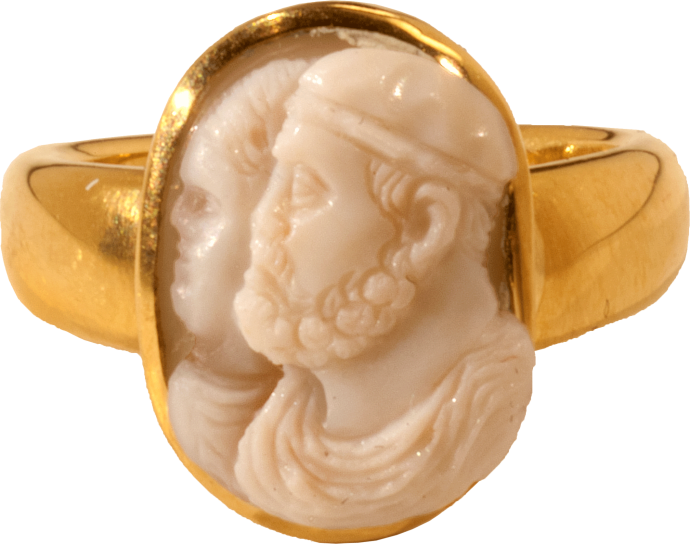


Renaissance Marriage Portrait Cameo Ring
, 16th-17th century



Renaissance Marriage Portrait Cameo Ring
Description
The Renaissance welcomed a revival in the ancient art of gem carving and cameos achieved renewed popularity. Important patrons, like the Medici, employed artists and goldsmiths to make dozens of beautiful examples that harkened back to antiquity and displayed current fashions. Double portraits of a man and woman, as with this ring, are called marriage portraits. They take their form from cameos of Roman rulers, mythological lovers, and citizen couples.
Substantial rounded D-section hoop, narrowing at the base supports an oblong collet set with a white agate cameo. The cameo features a female bust behind a male bust in profile facing to the viewer's left. The man has a curly beard, wears a fillet in his closely cropped hair, and wears a draped toga; the woman is less well defined and wears a palla. Both portraits have flat features. The carving has a metallic quality to its lines which enhances the sheen of the stone. The cameo is in excellent condition; the mount is modern.
Literature
This couple could be a sixteenth-century copy of an ancient gem or it could represent a Renaissnce couple in the guise of a Roman couple. The features do not point to any well-known couples. A double portrait cameo in the Royal Collection (RCIN 65861) provides a nice comparison to this ring and is from the same period. For an ancient example of the double portrait cameo see the Metropolitan Museum's Germanicus and Agrippina (39.22.18) cameo. Another comparison, see the Bibliothèque Nationale, Paris (a 17th-century cameo with the double portrait of a couple in a three-layered agate, published in Babelon, 1897, n. 1019). For general information on Renaissance cameos see Henig et al, 1994; Kris, 1930; and Cameo Appearances, 2008.
